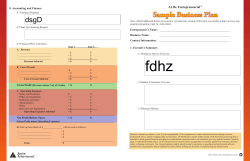
LTCB Monthly April 2015 - Lighthouse Tax & Business Consulting
1 Lighthouse Tax & Business Consulting April 2015 LIGHTHOUSE MONTHLY Tax Strategies & Tips for Small Businesses, Individuals and the Self Employed 6803 Whittier Avenue, Suite 200 McLean, VA 22101 phone: 703.847.2626 fax: 703.847.0855 email: info@lighthousetbc.com Estimated Tax Payments Recently, several new tax laws and changes took effect that add complexity to estimating one’s tax liability, including: higher ordinary tax rates, higher capital gains tax rates, the phase out of exemptions and itemized deductions for higher income taxpayers, the 3.8% tax on net investment income, and .9% increase in selfemployment tax for upperincome self-employed individuals, not to mention a myriad of sun setting tax provisions. Where’s My Refund Where’s My Refund? is an interactive tool on the IRS web site. Whether you split your refund among several accounts, opted for direct deposit into one account, or asked the IRS to mail you a check, Where’s My Refund? will give you online access to your refund information nearly 24 hours a day, 7 days a week. Education Tax Benefits The tax code includes a number of incentives that, with proper planning, can provide tax benefits while you, your spouse, or children are being educated. Which of these options will provide the greatest tax benefit depends on each individual’s particular circumstances. The following is an overview of the various possibilities. Student Loans - A major planning issue is how to finance your children’s education. Those with substantial savings simply pay the expenses as they go while others begin setting aside money far in advance of the education need, perhaps utilizing a Coverdell account or Sec. 529 plan. Others will need to borrow the funds, obtain financial aid, or be lucky enough to qualify for a scholarship. Although student loans provide one ready source of financing, the interest rates are generally higher than a home equity debt loan, which can also provide a longer repayment term and lower payments. When choosing between a home equity loan or student loan, keep in mind the following limitations: (1) Interest LighthouseTBC.com 1 2 Lighthouse Tax & Business Consulting April 2015 on home equity debt is deductible only if you itemize, and then only on the first $100,000 of debt, and not at all to the extent that you are taxed by the alternative minimum tax; and (2) student loans must be single-purpose loans—the interest deduction is available even if you do not itemize but is limited to $2,500 per year, and the deduction phases out for joint filers with income (AGI) between $130,000 and $160,000 ($65,000 to $80,000 for unmarried taxpayers). Gifting Low Basis Assets - Another frequently used tax strategy to finance education is to gift appreciated assets (typically stock) to a child and then allow the child to sell the stock to pay for the education. This results in transferring any gain on the stock to the child at a time when the child has little or no other income; tax on the gain is avoided or is at the child’s low rate. With the lowest of the long-term capital gains rates currently being zero, Congress curtailed income shifting to children by making most full-time students under the age of 24 subject to the “kiddie tax.” This effectively taxes their unearned income at their parents’ tax rates and makes the gifting of appreciated assets to a child less appealing as a way to finance college expenses. Education Credits - The tax code provides tax credits for post-secondary education tuition paid during the year for the taxpayer and dependents. Currently, there are two types of credits: the American Opportunity Credit, which is limited to any four tax years for the first four years of post-secondary education and provides up to $2,500 of credit for each student (some of which may be refundable), and the Lifetime Learning Credit, which provides up to $2,000 of credit for each family each year. The American Opportunity Credit is phased out for joint filers with incomes between $160,000 and $180,000 ($80,000 to $90,000 for single filers). The 2015 phaseout ranges for the Lifetime Learning Credit are $110,000–$130,000 for married joint and $55,000–$65,000 for others. Neither credit is allowed for married individuals who file separately. Careful planning for the timing of tuition payments can provide substantial tax benefits. Education Savings Programs - For those who wish to establish a formalized long-term savings program to educate their children, the tax code provides two plans. The first is a Coverdell Education Savings Account, which allows the taxpayer to make $2,000 annual nondeductible contributions to the plan. The second plan is the Qualified Tuition Plan, more frequently referred to as a Sec. 529 plan, with annual nondeductible contributions generally limited to the gift tax exemption for the year ($14,000 in 2015). Both plans provide tax-free earnings if used for qualified education expenses. When choosing between a Coverdell or Sec. 529 plan, keep the following in mind: (1) Coverdell accounts can be used for kindergarten through post-secondary education and become the property of the child at age of majority, and contributions are phased out for joint filers between $190,000 and $220,000 ($95,000 and $110,000 for others) of income (AGI); and (2) Sec. 529 plans are only for post-secondary education, but the contributor retains control of the funds and there is no phase out of the contribution based on income. Educational Savings Bond Interest—There is also an exclusion of savings bond interest for Series EE or I Bonds that were issued after 1989 and purchased by an individual over the age of 24. All or part of the interest on these bonds is exempt from tax if qualified higher education expenses are paid in the same year that the bonds are redeemed. As with other benefits, this one also has a phase-out limitation for joint filers with income between $115,750 and $145,750 ($77,200 and $92,200 for unmarried taxpayers, but those using the married filing separately status do not qualify for the exclusion). The exclusion is computed on IRS Form 8815, Exclusion of Interest from Series EE and I U.S. Savings Bonds Issued After 1989. LighthouseTBC.com 2 Lighthouse Tax & Business Consulting April 2015 Tax Break For Sales of Inherited Homes People who inherit property are often concerned about the taxes they will owe on any gain from that property’s sale. After all, the property may have been purchased years ago at a low cost by a deceased relative but may now have vastly appreciated in value. The usual question is: “Won’t the taxes at sale be horrendous?” Clients are usually pleasantly surprised by the answer—that special rules apply to figuring the tax on the sale of any inherited property. Instead of having to start with the decedent’s original purchase price to determine gain or loss, the law allows taxpayers to use the value at the date of the decedent’s death as a starting point (sometimes an alternate date is chosen). This often means that the selling price and the inherited basis of the property are practically identical, and there is little, if any, gain to report. In fact, the computation frequently results in a loss, particularly when it comes to real property on which large selling expenses (realtor commissions, etc.) must be paid. This also highlights the importance of having a certified appraisal of the home to establish the home’s tax basis. If an estate tax return or probate is required, a certified appraisal will be completed as part of those processes. If not, one must be obtained to establish the basis. It is generally not acceptable just to refer to a real estate agent’s estimation of value or comparable sale prices if the IRS questions the date of death value. The few hundred dollars it may cost for a certified appraisal will be worth it if the IRS asks for proof of the basis. Another issue is whether a loss on an inherited home is deductible. Normally, losses on the sale of personal use property such as one’s home are not deductible. However, unless the beneficiary is living in the home, the home becomes investment property in the hands of the beneficiary, and a loss is deductible but subject to a $3,000 ($1,500 if married and filing separately) per year limitation for all capital losses with any unused losses carried forward to a future year. In some cases, courts have allowed deductions for losses on an inherited home if the beneficiary also lives in the home. In order to deduct such a loss, a beneficiary must try to sell or rent the property immediately following the decedent’s death. In one case, where a beneficiary was also living in the house with the decedent at the time of death, loss on a sale was still deductible, when the heir moved out of the home within a “reasonable time” and immediately attempted to sell or rent it. This treatment could change in the future, however. The President’s Fiscal Year 2016 Budget Proposal includes a proposal that would eliminate any step up in basis at the time of death and would require payment of capital gains tax on the increase in the value of the home at the time it is inherited. If you have questions related to inheritances or home sales, please give this office a call. LighthouseTBC.com 3 Lighthouse Tax & Business Consulting April 2015 Writing off Start-up Expenses Business owners – especially those operating small businesses – may be helped by a tax law allowing them to deduct up to $5,000 of the start-up expenses in the first year of the business’s operation. This is in lieu of amortizing the expenses over 180 months (15 years). Generally, start-up expenses include all expenses incurred to investigate the formation or acquisition of a business or to engage in a for-profit activity in anticipation of that activity becoming an active business. To be eligible for the election, an expense must also be one that would be deductible if it were incurred after the business actually began. An example of a start-up expense is the cost of analyzing the potential market for a new product. As with most tax benefits, there is always a catch. Congress put a cap on the amount of start-up expenses that can be claimed as a deduction under this special election. Here’s how to determine the deduction: If the expenses are $50,000 or less, you can elect to deduct up to $5,000 in the first year, plus you can amortize the balance over 180 months. If the expenses are more than $50,000, then the $5,000 first-year write-off is reduced dollar-for-dollar for every dollar in start-up expenses that exceed $50,000. For example, if start-up costs were $54,000, the first-year write-off would be limited to $1,000 ($5,000 – ($54,000 – $50,000)). The election to deduct start-up costs is made by claiming the deduction on the return for the year in which the active trade or business begins, and the return must be filed by the extended due date. Qualifying Start-Up Costs – A qualifying start-up cost is one that would be deductible if it were paid or incurred to operate an existing active business in the same field as the new business and the cost is paid or incurred before the day the active trade or business begins. Not includible are taxes, interest, and research and experimental costs. Examples of qualified start-up costs include: • • • • • Surveys/analyses of potential markets, labor supply, products, transportation facilities, etc.; Wages paid to employees and their instructors while they are being trained; Advertisements related to opening the business; Fees and salaries paid to consultants or others for professional services; and Travel and other related costs to secure prospective customers, distributors, and suppliers. For the purchase of an active trade or business, only investigative costs incurred while conducting a general search for or preliminary investigation of the business (i.e., costs that help the taxpayer decide whether to purchase a new business and which one to purchase) are qualified start-up costs. Costs incurred attempting to buy a specific business are capital expenses that aren’t treated as start-up costs. If you have a question related to start-up expenses, please give this office a call. LighthouseTBC.com 4 Lighthouse Tax & Business Consulting April 2015 Employee Financial Wellness at Work Programs Gaining Popularity Along with 401(k) plans, Health & Wellness plans have historically been the main benefit focal point for employers. “Obamacare” has dominated the HR industry bulletins. In addition to our search and acceptance of affordable healthcare, our definition of healthcare has shifted to include much more than our annual exam, pediatric care for our children, prescription costs, and major medical coverage. Employers also realize that the aspects of mental health play a huge role in the productivity of every employee, the overall costs of healthcare, and thus the productivity and profitability of the employer. As employees, we may come to realize that the balance of work and non-work life can become more and more intertwined. Our personal success, or lack thereof, usually has an impact on our career and employment success. This includes our personal financial success. According to the American Psychology Association, 7 out of 10 American workers say financial stress is their most common cause of stress*. And we are bringing that stress into the workplace every day. According to SHRM (Society For Human Resource Management), 7 out of 10 HR professionals indicated that personal financial challenges have a large or some impact on their employees’ performance. Almost half state that employee stress and the ability to focus on work are the aspects of employee performance most negatively affected by personal financial challenges. For these reasons, and many more, Financial Wellness Programs may be coming to your employer soon! These programs are not only focused on unbiased and sound financial planning, but more importantly focus on changing and constantly improving an individual’s financial habits and behaviors. As an on-going program, offered both in group seminar environments during the workday, as well as individually tailored programs, these employer sponsored programs cover all aspects of proper financial wellness such as budgeting, immediate, short-term and long-term savings goals, navigating healthcare packages, wills, estate planning, and more. It’s not about what products are out there, it’s about changing and improving our habits, gaining critical education, and taking action on a plan that is understood with confidence. Another aspect of these programs is that we have three primary, and very different, generations of employees in the workforce. According to SHRM, the Baby Boomers are most concerned with Retirement Planning, and whether are not they can retire when and how they want to. The Generation X’ers are more interested in Investment Planning, with budgeting number three on their “needs” list, while the Millennial generation places almost equal needs with Investment and Budget Planning. As the way we look at our Employers continues to evolve, Financial Wellness At Work has become much more than your 401(k) benefit plan. Sound mind and sound body, we’ve all heard it before, are both important. Stress impacts all of us in different ways. Employers large and small are looking to Financial Wellness programs to bring education and assistance to everyone. LighthouseTBC.com 5
© Copyright 2025









